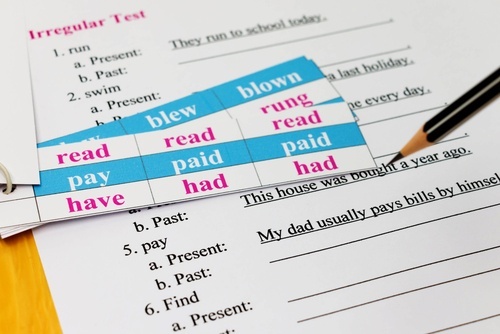Czas przeszły w języku angielskim - zastosowanie
Zacznijmy od zastosowania czasu Past Simple.
- odnosi się on do czynności i stanów, które rozpoczęły i zakończyły się w przeszłości i nie mają związku z teraźniejszością. Często pojawia się tutaj okolicznik czasu, a więc podajemy datę czy godzinę, lub w inny sposób określamy czas, kiedy dana czynność miała miejsce.
e.g. We played football yesterday.
Danny and Jessica got married when they were students.
My parents lived in a small town for many years.
- używamy go również, kiedy chcemy zapytać o czas, kiedy dana czynność się odbywała. Pytania takie zaczynać się będą od słowa “when” lub “what time”.
e.g. When did you last speak to your grandma?
What time did your daughters go to bed yesterday?
- czas Past Simple stosowany jest także, kiedy mówimy o nawykach, przyzwyczajeniach i powtarzalnych czynnościach w przeszłości.
e.g. When did you last speak to your grandma?
Mary went jogging every morning.
- tego czasu przeszłego użyjemy też w odniesieniu do czynności lub wydarzeń, które miały miejsce na tyle dawno, że bez szerszego kontekstu wiadomo, że nie mają związku z teraźniejszością.
e.g. The Chinese invented print.
Nobody really knows how Stonehenge was built.
- czas Past Simple występuje w drugim okresie warunkowym, w części określającej warunek.
e.g. If we lived in Paris, we could see the Eiffel Tower every day.
If Sonia didn’t neglect her duties at work, she would get higher bonuses.
If I were you, I wouldn’t be so rude to your teachers.
- używamy go również po wyrażeniach “I wish” i “If only”, dla wyrażenia żalu lub życzenia, aby teraźniejsza sytuacja wyglądała inaczej.
e.g. I wish my parents gave me more pocket money!
If only David didn’t object to our proposal!
“Was” i “were” - czas przeszły czasownika “to be”
Rozpoczynając naukę czasu przeszłego w języku angielskim, musisz pamiętać, że czasownik “to be” jest wyjątkowy i rządzi się swoimi prawami. Występuje w dwóch formach: “was” i “were”.
Przyjrzyjmy się bliżej odmianie tego czasownika. W przypadku zdań twierdzących, odmiana czasownika “to be” w czasie przeszłym wygląda następująco:
|
liczba pojedyncza |
liczba mnoga |
|
I was you were he was she was it was |
we were you were they were |
Np. You were really tired yesterday.
Samatha was very happy when Mick asked her out.
They were at home when the accident happened.
Aby utworzyć zdanie przeczące w czasie przeszłym prostym, wystarczy dodać słówko “not”, np. I was not at work last week. Pamiętaj, że język angielski kocha skróty i czas przeszły Past Simple nie stanowi tutaj żadnego wyjątku. Najbardziej naturalna i najczęściej występująca zatem forma wygląda następująco:
|
liczba pojedyncza |
liczba mnoga |
|
I wasn’t you weren’t he wasn’t she wasn’t it wasn’t |
we weren’t you weren’t they weren’t |
Np. She wasn’t sure what to do.
We weren’t ready to go.
I wasn’t there at that time.
Pytania tworzymy stosując tzw. inwersję. Proces ten polega na zamianie miejscami podmiotu i orzeczenia.
|
liczba pojedyncza |
liczba mnoga |
|
was I? were you? was he? was she? was it? |
were we? were you? were they? |
Pamiętaj! W czasie przeszłym prostym w języku angielskim “was” i “were” używane są tylko i wyłącznie dla wyrażenia przeszłej formy czasownika “być”. W przypadku, gdy w zdaniu występuje inne orzeczenie, na “was”/”were” nie ma już miejsca!
Czas przeszły - czasowniki regularne i czasowniki nieregularne
Powyżej omówiony został czasownik “to be”, który, jak wspomnieliśmy, jest wyjątkiem. Pozostałe czasowniki (poza czasownikami modalnymi, które opisane zostaną w osobnym poście) dzielą się na czasowniki regularne i nieregularne. Dobra wiadomość dla uczących się jest taka, że podział ten ma znaczenie jedynie w przypadku zdań twierdzących, w przeczeniach i pytaniach nie jest on w ogóle istotny.
W przypadku czasowników regularnych w czasie przeszłym dodajemy do nich końcówkę -ed, np. work - worked.
Trzy wyjątkowe sytuacje, o których należy pamiętać, to:
- czasowniki kończące się na literę -e. W ich przypadku dodajemy tylko -d: np. dance - danced, use - used,
- czasowniki kończące się na -y, przed którym jest spółgłoska, np. study. W takich przypadkach odrzucamy -y i dodajemy końcówkę -ied, np. study - studied, cry - cried,
- czasownik “travel” - w jego przypadku dodając końcówkę -ed, podwajamy -l: travel - travelled.
Czasowniki nieregularne wymagają nieco więcej uwagi. Niestety, nie istnieją żadne zasady, które ułatwiłyby ich pogrupowanie i pozostaje nauczenie się form nieregularnych na pamięć. Odradzamy próbę opanowania wszystkich czasowników nieregularnych za jednym podejściem. Lepsze efekty przynosi systematyczne uczenie się np. 3-5 czasowników nieregularnych dziennie. Każdy czasownik nieregularny wymaga zapoznania się z tzw. drugą i trzecią formą, które znajdziesz w ramce z czasownikami nieregularnymi.
|
bezokolicznik |
II forma - Past Simple |
III forma - używana w czasach perfectowych i stronie biernej |
znaczenie |
|
write |
wrote |
written |
pisać |
Past Simple - czas przeszły w języku angielskim wymaga użycia drugiej formy.
Należy pamiętać, że czasownik wygląda tak samo we wszystkich osobach, nie musisz się więc martwić odmianą.
Czas przeszły - tworzenie przeczeń i pytań
Przeczenia w czasie przeszłym w języku angielskim tworzymy przy pomocy operatora “did not” - takiego samego dla wszystkich osób. W formie skróconej przybiera on postać jednego słówka - “didn’t”. Czasownik występuje w formie podstawowej, np. We didn’t go to the cinema yesterday.
“Wzór” na zdanie przeczące w czasie Past Simple wygląda następująco:
podmiot + didn’t + czasownik w formie podstawowej
Pytania w czasie przeszłym angielskim tworzone są we wszystkich osobach przy pomocy operatora “did”. Także w tym przypadku czasownik pozostaje w formie podstawowej, np. Where did she go last weekend?
“Wzór” na pytania w czasie Past Simple wygląda tak:
(Wh-) + did + podmiot + czasownik w formie podstawowej
Zapraszamy do odwiedzania naszego bloga - w kolejnym wpisie znajdziesz dokładne omówienie czasu Present Continuous.
Potrzebujesz lepiej znać angielski?
Chcesz dodatkowych wskazówek?
ENGLISH VERSION
Past Simple - English past tense
The first English past tense that learners of english come across is Past Simple. Polish students are recommended to stick to English names - as we have explained in the previous post. It will allow you to avoid potential ambiguities and misleading translations. Today we are discussing in detail the structure and usage of Past Simple tense.
Past Simple tense - usage
Let us start with explaining when to use Past Simple.
- it refers to actions and states that started and finished in the past and have no connection with the present. Very often time is stated, when the activity took place.
e.g. We played football yesterday.
Danny and Jessica got married when they were students.
My parents lived in a small town for many years.
- it is also used to ask when the action happened. Such questions will start wit “when” or “what time”.
e.g. When did you last speak to your grandma?
What time did your daughters go to bed yesterday?
- you should use Past Simple to talk about habitual and repetitive actions in the past.
e.g. My grandfather always had tea for breakfast.
Mary went jogging every morning.
- this tense is used to talk about actions or events which took place such a long time ago that even without any further context it is clear they are not connected with the present.
e.g. The Chinese invented print.
Nobody really knows how Stonehenge was built.
- Past Simple is necessary to build Conditional II sentences, in the part expressing the condition.
e.g. If we lived in Paris, we could see the Eiffel Tower every day.
If Sonia didn’t neglect her duties at work, she would get higher bonuses.
If I were you, I wouldn’t be so rude to your teachers.
- it is also used after “I wish” and “If only” to express regret or wish that the present situation looked different.
e.g. I wish my parents gave me more pocket money!
If only David didn’t object to our proposal!
“Was” and “were” - past forms of “to be”
When you start learning about the past tense in English, you need to remember that the verb “to be” is unique and follows its own rules. There are two possible past forms of this verb: “was” and “were”.
Let’s have a closer look at them. In positive sentences they are used as follows:
|
singular |
plural |
|
I was you were he was she was it was |
we were you were they were |
e.g. You were really tired yesterday.
Samatha was very happy when Mick asked her out.
They were at home when the accident happened.
To make a negative sentence it’s enough to add “not”, e.g. I was not at work last week. You need to remember that English is famous for its love of short forms and PAst Simple is no exception here. That’s why the most natural and common form looks like this:
|
singular |
plural |
|
I wasn’t you weren’t he wasn’t she wasn’t it wasn’t |
we weren’t you weren’t they weren’t |
e.g. She wasn’t sure what to do.
We weren’t ready to go.
I wasn’t there at that time.
Questions are made by so-called inversion. It simply means that the subject and the verb switch places.
|
singular |
plural |
|
was I? were you? was he? was she? was it? |
were we? were you? were they? |
Remember! In Past Simple tense “was” and “were” are only used to express the verb “to be” in the past. If there is another verb in the sentence - “was” and “were” shouldn’t be used!
Past Simple tense - regular and irregular verbs
The above discussed verb “to be” is - as said - unique. All other verbs (with the exception of modal verbs which are going to be explained in a separate post) can be divided into regular and irregular ones. The good news for English learners is that this division only matters in positive sentences. In questions and negative sentences it is not important at all.
In case of regular verbs in Past Simple tense the ending -ed is added, e.g. work - worked.
There are three exceptional cases that need to be remembered about:
- verbs ending in -e. In this case you only add -d, e.g. dance - danced, used - used.
- verbs ending in -y after a consonant, e.g. study. In this case -y is dropped and the ending -ied is used, eg. study-studied, cry - cried.
- the verb “travel” - remember to double the -l at the end: travel - travelled.
Irregular verbs need a bit more attention. Unfortunately, there are no rules that would allow for grouping or categorizing them and the only thing you can do is to actually learn them by heart. We advise not to try to learn all of them in one go. It’s more efficient to systematically learn 3-5 irregular verbs a day. Each irregular verb has the second and the third form that need to be learnt. You will find all of them in the irregular verbs chart.
eg.
|
infinitive |
II form - Past Simple |
III form - used in perfect tenses and |
|
write |
wrote |
written |
In Past Simple the second form is used.
It’s good to remember that the verb has the same form for all person.
Past Simple tense - negative sentences and questions
Negative sentences are created by using the auxiliary verb “did not” - the same for all persons. In the short versions it becomes “didn’t”. The verb goes in the base form. e.g. We didn’t go to the cinema yesterday.
A “formula” for negative sentences in Past Simple looks like this:
subject + didn’t + verb in the base form
Questions in Past Simple are made for all persons with the auxiliary verb “did”. Also in this case the verb goes in the base form. e.g. Where did you go last weekend?
A “formula” for questions in Past Simple is as follows:
(Wh-) + did + subject + verb in the base form
Drop in on our blog - in the next post you’ll find all the information you need about the Present Continuous tense.
Potrzebujesz lepiej znać angielski?
Chcesz dodatkowych wskazówek?







